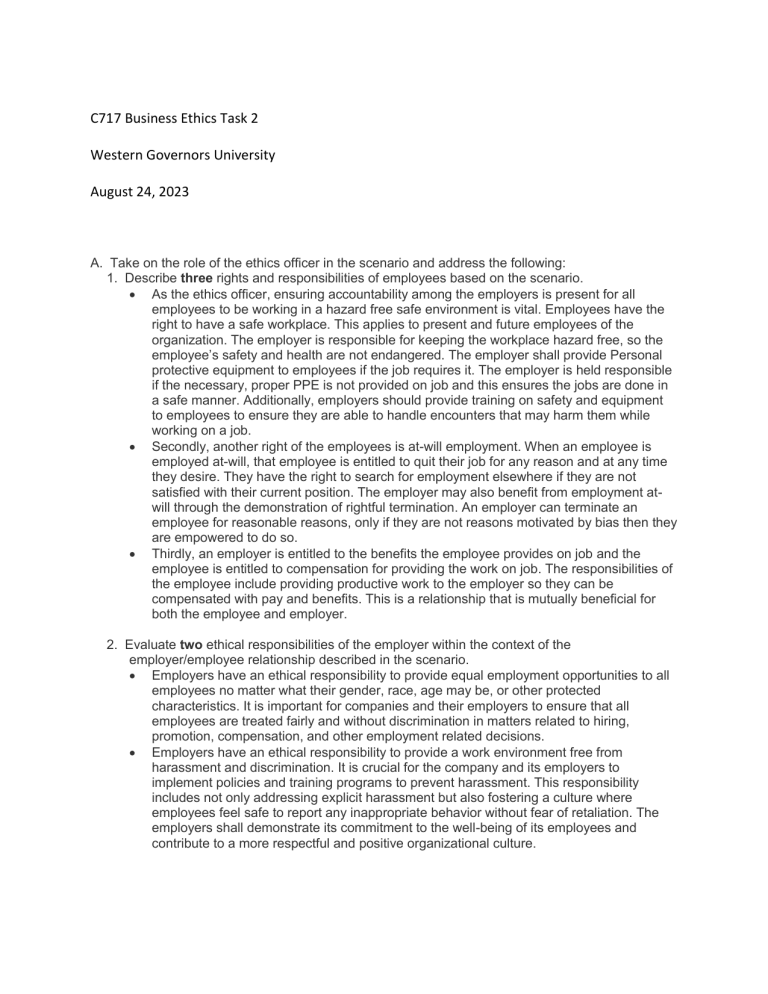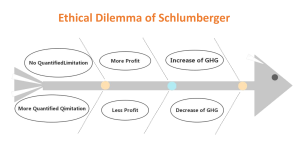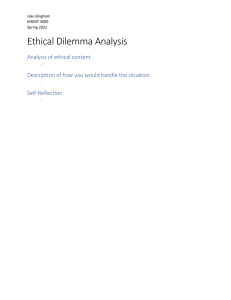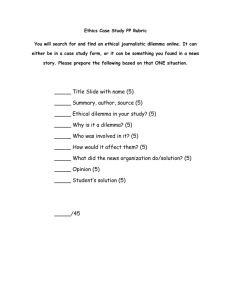
C717 Business Ethics Task 2 Western Governors University August 24, 2023 A. Take on the role of the ethics officer in the scenario and address the following: 1. Describe three rights and responsibilities of employees based on the scenario. As the ethics officer, ensuring accountability among the employers is present for all employees to be working in a hazard free safe environment is vital. Employees have the right to have a safe workplace. This applies to present and future employees of the organization. The employer is responsible for keeping the workplace hazard free, so the employee’s safety and health are not endangered. The employer shall provide Personal protective equipment to employees if the job requires it. The employer is held responsible if the necessary, proper PPE is not provided on job and this ensures the jobs are done in a safe manner. Additionally, employers should provide training on safety and equipment to employees to ensure they are able to handle encounters that may harm them while working on a job. Secondly, another right of the employees is at-will employment. When an employee is employed at-will, that employee is entitled to quit their job for any reason and at any time they desire. They have the right to search for employment elsewhere if they are not satisfied with their current position. The employer may also benefit from employment atwill through the demonstration of rightful termination. An employer can terminate an employee for reasonable reasons, only if they are not reasons motivated by bias then they are empowered to do so. Thirdly, an employer is entitled to the benefits the employee provides on job and the employee is entitled to compensation for providing the work on job. The responsibilities of the employee include providing productive work to the employer so they can be compensated with pay and benefits. This is a relationship that is mutually beneficial for both the employee and employer. 2. Evaluate two ethical responsibilities of the employer within the context of the employer/employee relationship described in the scenario. Employers have an ethical responsibility to provide equal employment opportunities to all employees no matter what their gender, race, age may be, or other protected characteristics. It is important for companies and their employers to ensure that all employees are treated fairly and without discrimination in matters related to hiring, promotion, compensation, and other employment related decisions. Employers have an ethical responsibility to provide a work environment free from harassment and discrimination. It is crucial for the company and its employers to implement policies and training programs to prevent harassment. This responsibility includes not only addressing explicit harassment but also fostering a culture where employees feel safe to report any inappropriate behavior without fear of retaliation. The employers shall demonstrate its commitment to the well-being of its employees and contribute to a more respectful and positive organizational culture. 3. Develop one ethical business dilemma that can be used to demonstrate employee understanding of the company’s ethical standards. Scenario: Company A is a manufacturing company that produces electronics. The company is known for its commitment to sustainability and ethical business practices. One of the key parts for a product they produce is sourced from a supplier. The supplier is known for providing highquality parts at a competitive price. However, there have been recent reports that the supplier has participated in unethical labor practices in their manufacturing facility, including child labor and hazardous working conditions. Company A relies on that one key part that the supplier produces, and finding an alternative supplier that has the same high quality and same price standards could take months. Ethical Dilemma: Being an employee for Company A, you have become aware of the unethical practices of the supplier. The dilemma poses a significant challenge which includes upholding Company A’s commitment to sustainability and ethical practices while ensuring a stable supply chain for their products. You are responsible for overseeing the supply chain management, and your decision could have severe consequences. Should you continue to use the supplier or seek an alternative supplier? 4. Evaluate the dilemma from part A3 from a utilitarian and relativistic perspective. Utilitarian perspective: The focus from this perspective is increase overall happiness and decrease harm for as many people as possible. In this scenario, the decision to continue using the unethical supplier or seek an alternative supplier should be evaluated based on the potential consequences for various stakeholders. If proceeding to use the unethical supplier leads to stableness in the supply chain and ensures products will be produced and delivered on time, then it may be seen to ensure overall happiness for the company, the employees, and the customers. The benefit would be avoiding delays in production and delivery of products which can lead to financial loss. However, seeking an alternative supplier that stands by good ethical practices may lead to delays in production and delivery which could then lead to an inconvenience to the customers and in turn, negative consequences. Relativistic Perspective: From this standpoint, the ethical decisions are influenced by individual and cultural values. Employees may interpret the situation in a different way based on their personal standards and morals. In this scenario, continuing to use the unethical supplier may be in favor of some employees to prioritize the company’s supply chain and financial stability. It may seem to these employees that it’s a practical reality of business and they also see it as maintaining jobs, capital, and business success. However, the employees with strong ethical standards may find it hard to engage with a business that engages in wrongful practices. Seeking an alternative supplier may be supported by the ones who have high value on ethics. These employees could argue that supporting ethical standards in the company is vital for their reputation, customer trust, and positive social change. The employees who are more profit based might be concerned of the negative impact on the performance of the company’s financials. 5. Describe two common ethical decisions that reflect corporate ethics and responsibilities that employees can face while working in a corporate setting. 1. The handling of confidential information: Employees may be handling confidential or sensitive information in a corporate setting. The problem arises when there is confidential information in the hands of an employee that may benefit them personally or to be used in a scheme. This can lead to legal consequences, and it would most certainty breach trust. The employee faces the decision to keep sensitive information confidential. This decision aligns with corporate ethics and responsibilities by upholding the trust placed in the employee to protect sensitive information. They should follow company policies and legal regulations regarding data privacy and confidentiality. By doing so, the employee demonstrates integrity and a commitment to the company values. 2. Performance Report honesty: Employees may face pressures to falsify or manipulate performance data to make the company’s financial appearance look better than it is. Falsifying the data could mislead investors, the public, and stakeholders, making short term benefits but long-term consequences. When an employee is pressured to manipulate performance data to present better financial picture than reality, they face an ethical decision. Choosing honesty and accuracy over falsification aligns with corporate ethics and responsibilities. By accurately representing the company’s performance, the employee ensures transparency for investors, stakeholders, and the public. This decision reflects the employee’s commitment to long-term substantiable success and builds trust with stakeholders, even if short-term gains might be sacrificed. In conclusion, in both scenarios, the ethical decisions made by employees reflect their dedication to upholding corporate ethics and responsibilities, even when faced with potential personal gain or external pressures. These decisions contribute to the overall ethical culture of the company and its reputation in the business world. 6. Explain why each ethical decision in part 5 presents an ethical dilemma and how an individual might justify unethical behavior (e.g., common excuses). Ethical Decision-The handling of confidential information: Ethical Dilemma: The dilemma in this scenario arises from the clash between personal gain and the responsibility to maintain confidentiality and trust. Employees might be tempted to use confidential information for their own benefit, even though doing so would breach the trust placed in them by the company and potentially lead to legal consequences. Alignment with Corporate Ethics and Responsibilities: Handling confidential information with integrity and following company policies aligns with corporate ethics and responsibilities in several ways: 1. Trust and integrity: upholding the confidentiality of sensitive information demonstrates a commitment to trust and integrity, both crucial aspects of maintaining a healthy corporate culture. 2. Data privacy: Following legal regulations and company policies regarding data privacy respects individuals’ rights and ensures compliance with data protection laws. This protects both the company and individuals from legal consequences. 3. Company Values: Many organizations have values that include integrity, respect, and accountability. Choosing to keep confidential information confidential aligns with these values and fosters a culture of responsible behavior. Justification for unethical behavior: An individual might justify unethical behavior by believing that since they’re not directly harming anyone, and the breach won’t be discovered, it’s not a big deal. They might feel entitled to use the information for personal gain due to their role in the company or their perceived contributions other employees in the company may be partaking in this unethical behavior, making it seem more acceptable. An individual might rationalize their actions by arguing that they’re in dire financial need, and using the confidential information could provide them with much needed financial relief. Ethical decision- Performance report honesty: Ethical Dilemma: The dilemma in this case is between short-term gains through manipulation of performance data and the long-term integrity and honesty required for sustainable business practices. Employees may be under pressure to inflate numbers to create a positive appearance, even if it involves misleading stakeholders. Alignment with Corporate Ethics and Responsibilities: Choosing honesty and accuracy over manipulating performance data aligns with corporate ethics and responsibilities in the following ways: 1. Transparency: Accurate reporting reflects transparency, a core principle of ethical business practices. This transparency ensures that stakeholders have an accurate understanding of the company’s financial health and operations. 2. Stakeholder Trust: Honest reporting builds and maintains trust with investors, shareholders, customers, and the public. Trist is vital for long-term relationships and sustainable success. 3. Long-Term Success: Prioritizing the truth over short-term gains reflects a commitment to the company’s long-term success. Accurate reporting allows the organization to identify and address challenges honestly, leading to better decision making and improved performance overtime. Justification for unethical behavior: Employees might justify this behavior by arguing that they’re ensuring the company meets its financial targets, which could lead to stability and job security for themselves and colleagues. They might view the manipulation as a temporary measure to overcome a challenging period, with the intention to rectify it later. Additionally, some individuals might assert that the business environment is inherently complex, and these actions are a way to navigate it effectively. - In both scenarios, the ethical dilemmas arise from conflict between personal interests and the broader ethical responsibilities and values of the company.



